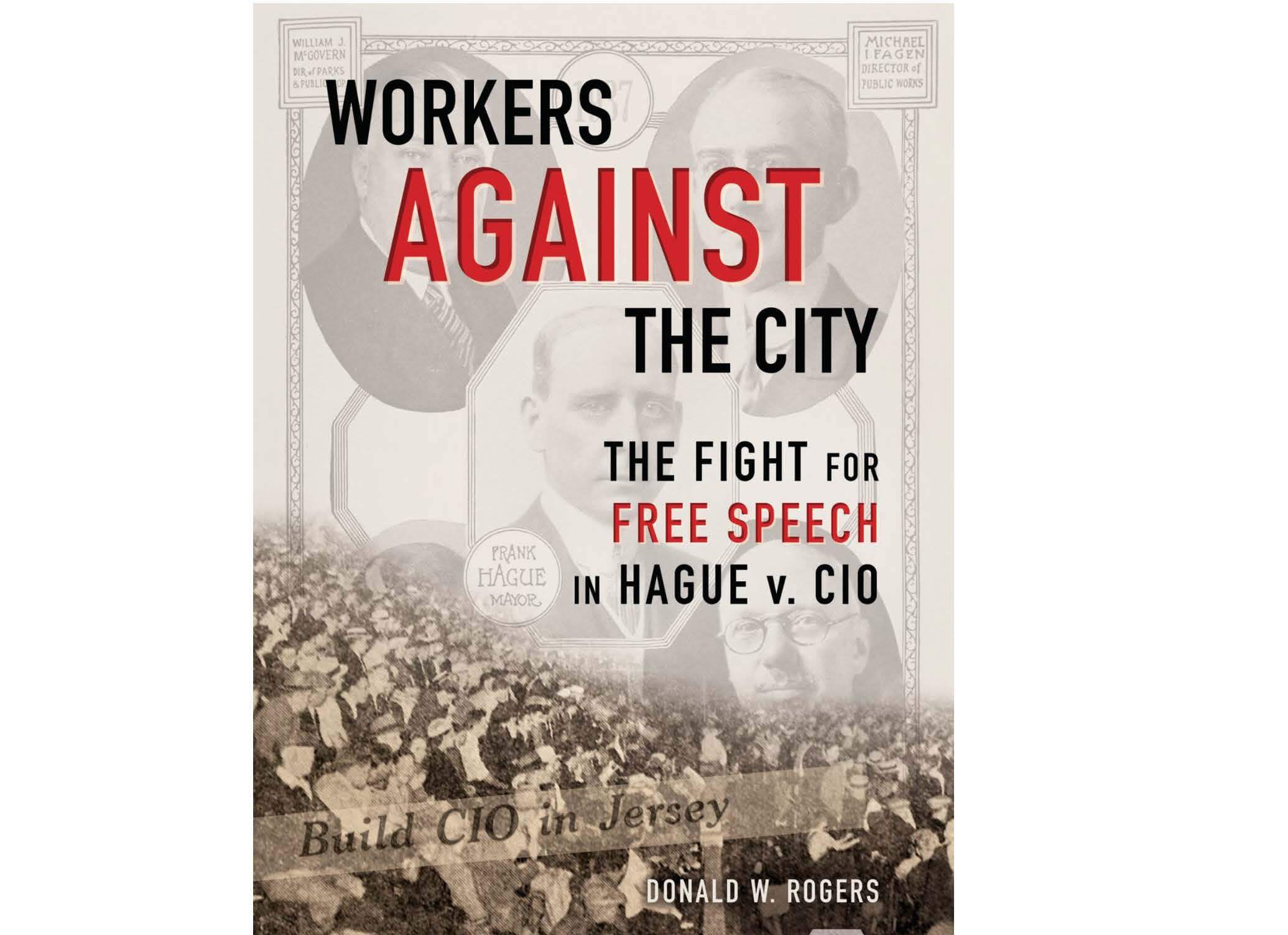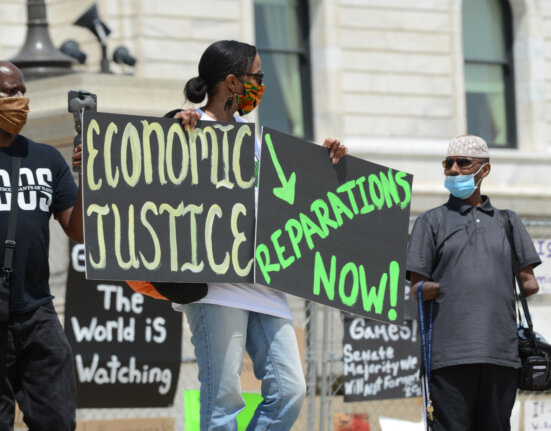Donald Rogers recent book Workers against the City: The Fight for Free Speech in Hague v. CIO (2020) reminds us of the terrific struggles that workers endured against policing, and the way that these struggles led to the fight for civil liberties. Frank Hague was a Jersey City, N.J. Democratic Party boss who banned picketing and distribution of leaflets on public property by the newly organized Committee of Industrial Organizations in 1937. He claimed the CIO was a Communist organization and used a city ordinance that banned gatherings of groups that advocated obstruction of government by unlawful means. Hague used the city police to brutally suppress organizing drives. As they did in the South, CIO’s organizers compared Hague’s iron rule to Hitler, using anti-fascism as a call to action. Led by the CIO’s left-wing Lee Pressman, they also took the case to the courts in coalition with the American Civil Liberties Union. I asked Prof. Rogers a few questions that highlight some of this story.
I checked with a few other labor historians, and they had never heard of the Hague v. CIO case. So, take a shot at the case for why they should know about it, why it matters, and what brought you to write this book?
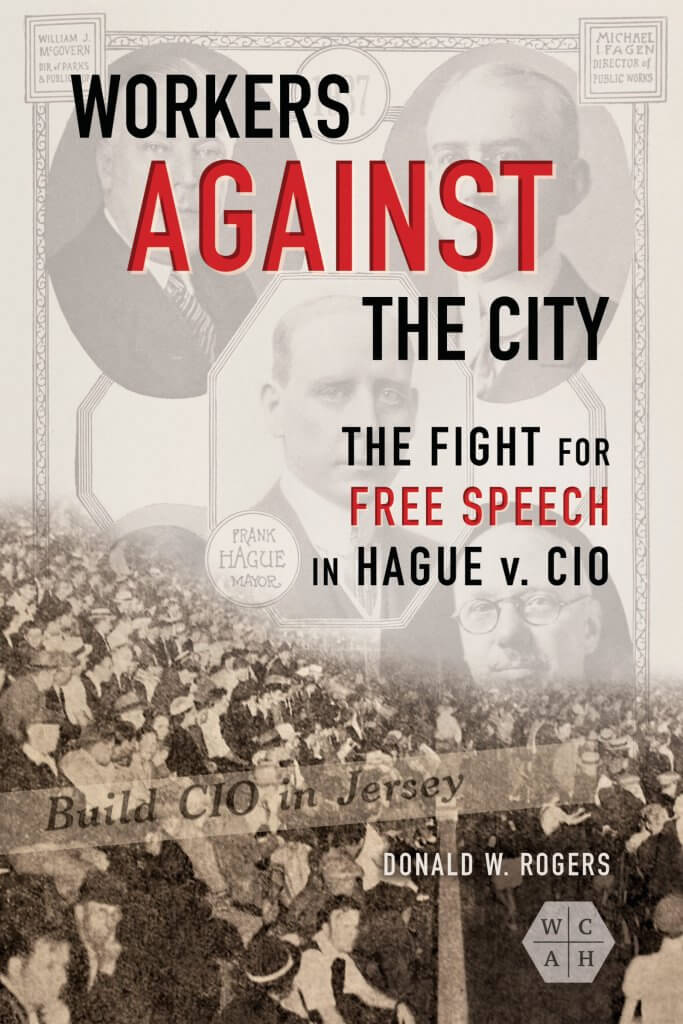
Many thanks for inviting my participation in this blog.
Labor historians most definitely should know about Hague v. CIO (1939), because it illuminates a critically overlooked phase of labor history when working-class organizers were leading catalysts in the fight for free expression rights—in this case, the right of public assembly. That’s what got me interested in the case. With my strong interest in civil liberties history, I was struck by how little historians have said about labor’s singular importance in pushing for such rights in the 1930s when modern free expression law was in its formative development before the federal courts.
Labor historians have perhaps neglected Hague, because of its reputation as merely a court victory by American Civil Liberties Union litigators over an authoritarian city boss, Mayor Frank Hague of Jersey City, whose city police department suppressed labor activists’ leafleting efforts and public meetings, as well as union organizing.
That prevailing image, however, obscures labor’s importance in the case. The Committee for Industrial Organization (as it was then called) initiated the litigation on the grounds that its organizers had every legal right to disseminate leaflets and hold rallies in Jersey City. Moreover, the CIO attracted support not only from the ACLU, but also from a large coalition of left-leaning pro-labor groups associated with the Popular Front, including socialists, communists, and the Worker Defense League along with journalists and civil libertarians.
Most importantly, Hague marked the culmination of an era when free expression rights were centrally connected to labor agitation. That association went back at least to the Industrial Workers of World’s “free speech fights” in the early-1900s and carried through the 1920s and 1930s. The association rested on the principle that workers had a right to outdoors agitation in a capitalist society that stymied other avenues for worker expression. The early ACLU embraced this view. And the CIO carried the idea forward in 1937 when its members entered Jersey City to organize unions, arguing that leafletting, street rallies and other public expressive activities were an integral part of labor unionizing protected under the newly-enacted National Labor Relations Act.
Your book’s description of the violence organizers faced reminded me of some of the brutal examples from Southern organizing. Is that fair comparison? What was the role of anticommunism in the world of boss Hague’s police department and why it mattered to CIO organizing? What made civil rights (to speak and picket) so difficult in this era?
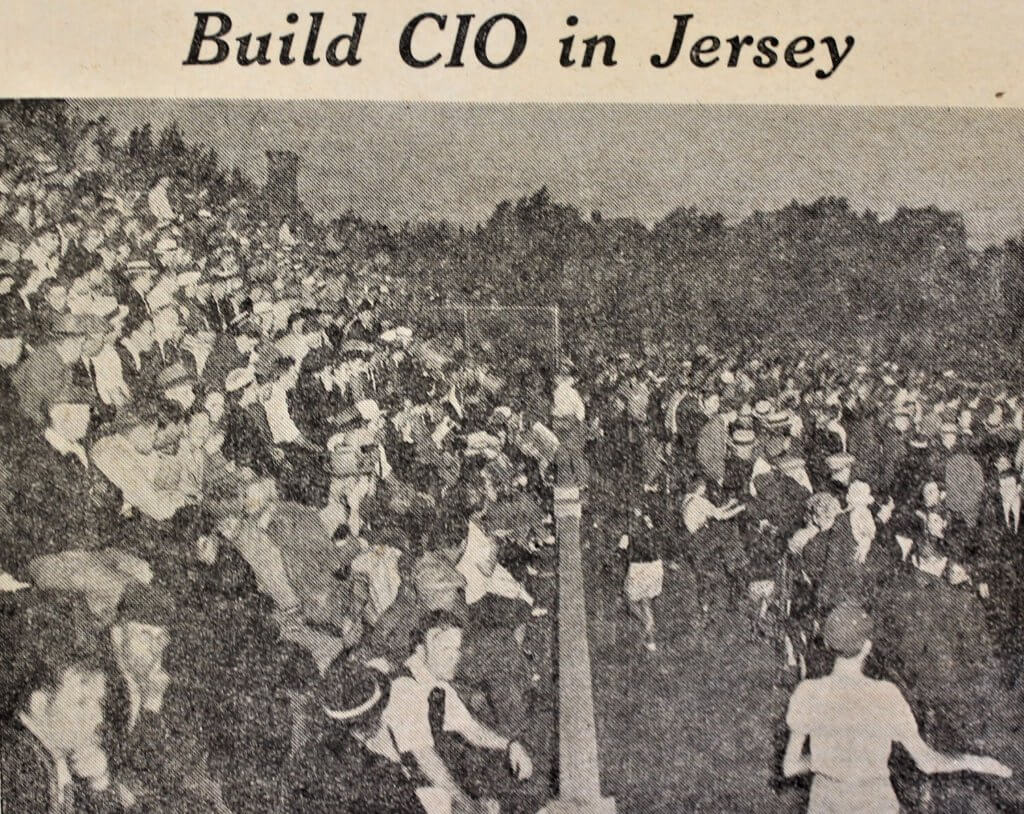
One thing that the Hague-versus-CIO affair had in common with violence-plagued southern labor organizing was the lingering post-Reconstruction constitutional framework under which both occurred. Constitutional jurisprudence in the early-1930s still left authority over labor and free expression rights in the hands of state and municipal officials who often ran roughshod over labor speech and picketing. Only slowly did U.S. Supreme Court decisions erode that jurisprudence by applying federal free expression rights on the local level under the Fourteenth Amendment. Similarly, labor organizing rights did not largely come under federal protection until passage of New Deal labor laws. Hague was part of that change. It signaled the end of the post-Reconstruction constitutional regime by affirming federal courts’ jurisdiction to protect the national rights of labor organizers and other Americans to assemble and speak in public places, a counterweight to much abused local police powers.
Beyond this, significant differences distinguish Jersey City’s conflict from the South’s more violent labor struggles. Notoriously, in Gastonia, North Carolina, Birmingham, Alabama and Harlan County, Kentucky, labor strife erupted between union organizers and heavy-handed manufacturers and coal mining firms, with shootings and other acts of violence committed by both sides. Local government intervened mainly to impose order and provide police support for employers. Vigilantism against labor organizers in the South intensified violence, and race figured centrally, as white supremacists used anti-communist rhetoric to discredit biracial labor action.
Jersey City’s conflict, however, was a political clash between Mayor Hague’s rather typical northern urban machine and outside CIO organizers. Both the local Chamber of Commerce and local American Federation of Labor unionists certainly opposed the CIO, but this was primarily Hague’s fight, which he perpetrated with strict law-and-order policing in an era of rampant police violence across northern cities. Jersey City violence consisted of police sluggings and manhandling of labor organizers and supporters, who themselves were overwhelmingly peaceful. Race was not a factor. But anti-communism magnified Hague’s resistance to the allegedly communist-dominated CIO, especially as that outlook permeated Jersey City’s conservative, largely Roman Catholic immigrant culture, particularly in the American Legion, a core of the nation’s Interwar anti-communist crusade.
It seems that the full hopes of what might happen with a Supreme Court ruling that ostensibly defended workers’ right to the streets never came about as fully guaranteed even though they won the court case.
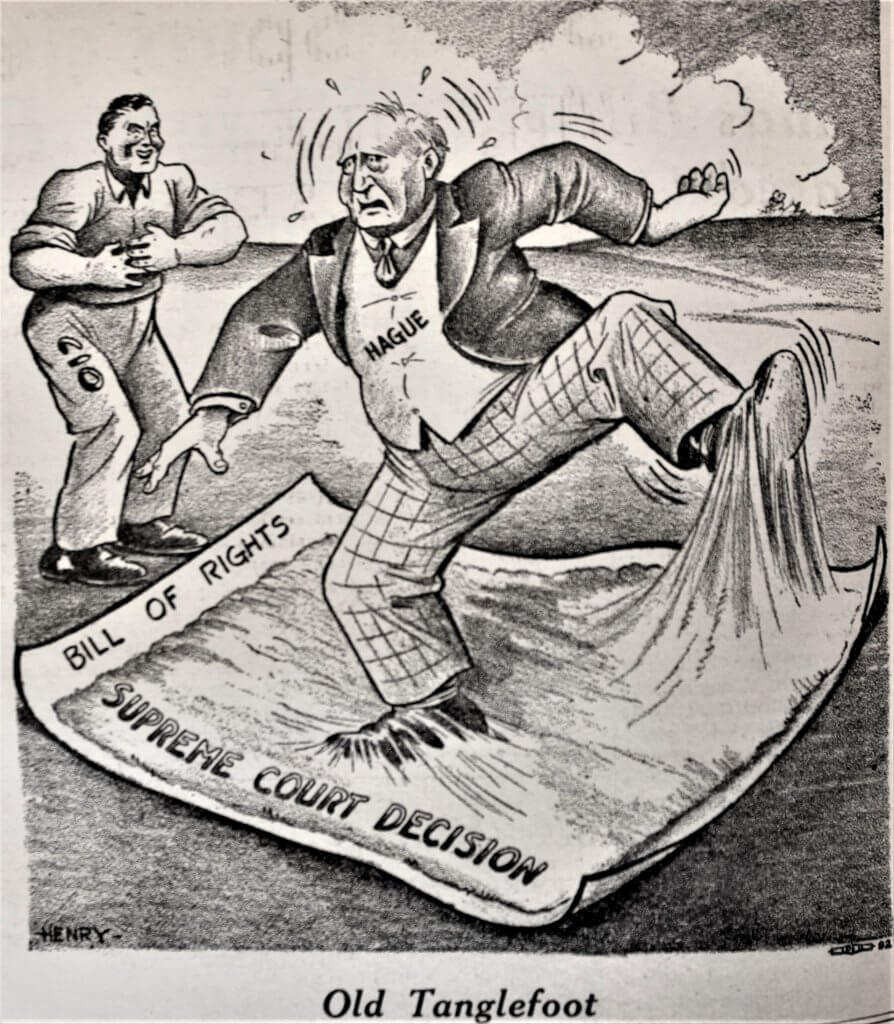
Legally, Hague v. CIO did fall short of CIO organizers’ hopes for a clear-cut victory on behalf of labor rights, but the ruling was complicated and ended up benefitting the CIO in some ways.
In 1938, the fledgling CIO was just starting its legal office in Washington D.C. under the direction of Lee Pressman. Consequently, the CIO’s partner in the case, the better-established ACLU, took over legal work with the assistance of a prominent Newark lawyer acting for the CIO. Civil rights (or civil liberties) law was in flux at the time, and the ACLU imposed its own philosophy by framing Jersey City’s abuses against CIO organizers in terms of free speech and public assembly violations under the First and Fourteenth Amendments, not interference with labor organizing rights.
Lower federal courts followed the ACLU’s civil libertarian reasoning, but the U.S. Supreme Court’s plurality opinion by Justice Owen Roberts took a narrower legal tact. He declared that Jersey City’s abuses interfered with CIO members’ rights as U.S. citizens to assemble to discuss matters of public concern (specifically the National Labor Relations Act) under the Fourteenth Amendment’s privileges and immunities clause. A broader concurrence by Justice Harlan Fiske Stone urged instead application of First Amendment rights as incorporated into the Fourteenth Amendment due process clause, and this ultimately became the Court’s jurisprudence.
At that moment, CIO lawyer Lee Pressman still maintained that civil liberties and labor rights were interwoven. He argued that the Court’s defense of public assembly rights created a powerful tool for deflecting local harassment of labor organizers. Unfortunately, subsequent Supreme Court rulings separated labor organizing (including picketing) from public assembly as a matter of law, weakening benefits that workers might get from Hague. Labor rights and civil liberties diverged. The CIO and ACLU went separate ways, even holding separate victory rallies in Jersey City.
Nonetheless, once Hague guaranteed public assembly, the CIO prospered in Jersey City. Hague’s regime had to accommodate CIO unions. Then, as World War II approached, the CIO organized many plants in Jersey City and held national conventions there. Remarkably, Jersey City became a union town.
Your book fits alongside Risa Goluboff’s reexamination of the relationship between groups like the ACLU and CIO in pursuing civil rights alongside labor rights. How does it contribute to thinking about the role of law, and what new dimensions do you contribute to this reevaluation?
Professor Goluboff’s book The Lost Promise of Civil Rights (2007) offers the trenchant point that civil rights law was up for grabs during the 1930s. Because race-based legal claims were not viable at the time, she argued, lawyers in the NAACP and the justice department’s Civil Rights Section turned to worker-based claims that were appealing during the Great Depression and New Deal in order to defend Blacks from the Jim Crow system.
As author of a book on Hague v. CIO, I find her point about the blurred categories of civil rights law in the 1930s to be compelling. The distinctions that we make today between racial discrimination and economic harm, and between Black civil rights, labor rights and civil liberties had not yet developed in the 1930s, and that allowed cross-group collaboration, as for example, the NAACP’s interest in the unionization of Black workers once the CIO got going.
My book on Hague corroborates that the blurring of civil rights categories in the 1930s created opportunities for progress. The blurring between worker rights and civil liberties encouraged the CIO’s and the ACLU’s cooperation in the case. It also abetted the Hague decision’s linkage between free speech and assembly rights, and workers’ rights to free association.
The Hague case did not, however, blend race-based claims with labor or civil liberties claims. Nothing in the case indicates that the CIO entered Jersey City explicitly to improve the lot of Black workers, or that Jersey City resisted the CIO for racial reasons. African Americans constituted only about 4.6 percent of Jersey City’s population, and they were consigned mostly to transportation, domestic and personal service jobs, not factory work targeted by the CIO. Nor, we might add, does evidence show that the CIO entered the city to support women’s rights, although many women were hard-suffering sweatshop workers, and a few were activists in allied pro-labor groups. At its time, Hague was thoroughly a labor and civil liberties case, not a racial or gender justice case. By happenstance, however, Hague did provide a crucial legal precedent for Black civil rights demonstrations in the 1960s.
How does your book inform the current efforts to have a broader field for labor’s free speech rights?
Hague v. CIO’s central contribution to labor speech is the so-called “public forum doctrine,” the principle that workers and any other residents of the United States have a fundamental right to use government-owned public spaces to assemble and speak on issues of public interest, including workers’ right to collective action to improve their working conditions.
Much debate about “labor speech” nowadays, however, goes in a different direction toward the extent of workers’ free expression rights as employees in the workplace. Can employees discuss working conditions like harassment or wage levels on the job, and can they engage in public rallies involving political matters like discrimination or mask mandates outside of the workplace without being disciplined by their employers? The issue is complicated, depending upon whether workers labor for public or private employers (the First Amendment does not apply to the latter), and what other laws like state constitutions, the National Labor Relations Act, anti-harassment measures or whistle-blower statutes apply. A legal battle rages over the balance between workers’ expressive freedom and employer restrictions, particularly in regard to when worker speech “adversely” affects work processes.
The Hague precedent, however, still leaves a wide field for worker expression in public space, although post-World War II court decisions have narrowed it. Supreme Court rulings have contracted what counts as a “public forum” (not transportation hubs or private shopping malls, eg.), and they put limits on peaceful labor pickets. On the latter, after broadly sanctioning the speech elements of labor picketing in the 1940 Thornhill and Carlson decisions, the Court backtracked by nullifying picketing laced with violence or prone to illegal purposes, and by circumscribing labor protestors’ outdoor picketing and leafletting rights on commercial property. Nonetheless, workers still enjoy with other Americans the expansive right established in Hague to meet in public spaces and discuss their concerns.
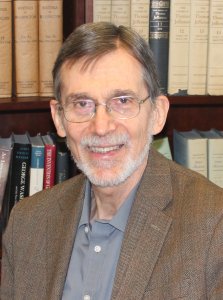
Donald W. Rogers is a retired adjunct lecturer in history from Central Connecticut State University and other institutions. He earned his M.A. and Ph. D. in American legal and constitutional history from the University of Wisconsin-Madison (1983), and has previously published Making Capitalism Safe: Work Safety and Health Regulation in America, 1880-1940 (2009) and journal articles on law and civil liberties history.

